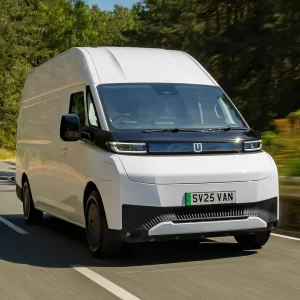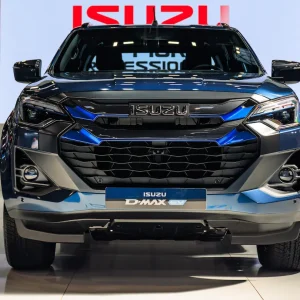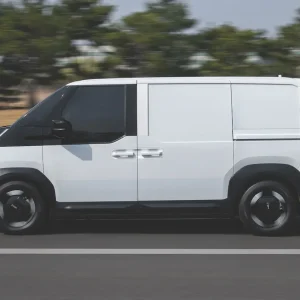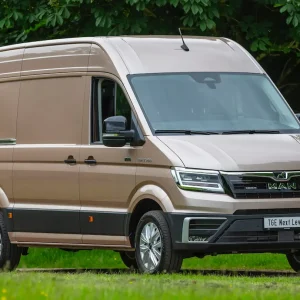Ford won a raft of prizes at the What Van? Awards 2023, including several accolades for its market-leading vehicles in the Manufacturer categories: The highlight was the New, All-Electric Ford E-Transit, which not only won Large Van of the Year but was also crowned the overall Van of the Year.
Ford carefully laid the groundwork before launching the E-Transit, which has raised the bar for large electric vans.
The manufacturer unveiled the electric version of its iconic large van at the end of 2020 and at the same time announced a range of upgrades to its suite of fleet management tools to support the newcomer’s pending arrival.
Ford then undertook customer trials of the van in 2021 to allow its engineers to gather data to refine the E-Transit’s connected vehicle and range management features.
When the E-Transit came to market in the Spring of 2022 it was clear the meticulous preparation had paid off.
A range of up to 196-miles* makes the E-Transit a viable option for customers who need it for inter-city, as well as inner-city missions. Then there is the starting price of around £42,000 (RRP excluding VAT + the PiVG), which puts the E-Transit within reach of customers who may otherwise have considered a large electric van, or a fleet of large electric vans, beyond the reach of their budgets. Next up is the power – a 198kW electric motor producing a blistering 269PS and 430Nm of torque.
Ford launched the model with 25 variants, including short-, medium- and long-wheelbase panel vans with two roof heights. There are also three gross vehicle weights, so you can have an E-Transit van at 3.5t, 3.9t or 4.25t, enabling a maximum payload of up to 1711kg for the panel van models and up to 2,090kg for a chassis cab.
It’s by far the most complete line-up of any electric van currently on sale and was the most eagerly anticipated new vehicle to arrive on the market in 2022.
As well as a 198kW motor, the E-Transit is available with a 135kW option producing 184PS. Despite nearly one third less power, it’s still a brisk van and retains the same amount of torque.
The 68kWh battery is bolted underneath the chassis of the van in a heavily protected steel casing.
Power is through the rear wheels, which is where the motor is located within the axle. Ford has re-engineered the rear suspension, placing the new independent coil springs away from the chassis. Electric vans are always quiet, of course, but by installing the motor in the rear of the van there’s a long way between the driver and the most obvious source of noise.
The E-Transit’s cab hosts a 12in touchscreen that runs Ford’s latest SYNC 4 system. The screen displays infotainment, wireless smartphone pairing and is the brains behind the van’s integration with the Ford Pro™ E-Telematics system and FordPass Pro, enabling vehicle pre-conditioning, remote start, charging schedules and location. SYNC 4 gets regular over-the-air, wireless software updates, to ensure continuous development. The screen, along with the digital display in the dash cluster, also shows information about the van’s driving modes, power consumption and battery status with an intelligent range predictor to give drivers an accurate estimate of their range based on driving style, weather, and traffic.
There are two different levels of regenerative braking and three driving modes. Rapid charging on a 115kW charger allows a top-up from 15% to 80% in 34 minutes**.
The arrival of the E-Transit is a huge moment for the mass uptake of electric vans, but Ford hasn’t simply thrown an electric drivetrain at the regular van. New rear suspension, and enhanced connectivity represent a step forward for the Transit and with new optional features like Pro Power Onboard, which facilitates running tools and lights off the vehicle’s battery, it’s a game-changer for customers too.
The E-Transit took the big prize, but Ford had plenty more to celebrate at the What Van? Awards. The UK’s best-selling vehicle, the Transit Custom, was handed the Medium Van of the Year accolade. Great to drive and a practical load lugger, with an excellent range of 2.0l EcoBlue diesel engines.
Ford has announced that the All-New Transit Custom, due to come to market in 2023, will be available with a revised range of 2.0l EcoBlue diesel engines, an all-new plug-in hybrid powertrain and for the first time, as a fully electric vehicle.
Quite simply, the Transit Custom is the best driver-focused van on the market and has been for a long time.
The Transit Custom’s payloads range from 686kg up to 1,459 kg with gross vehicle weights from 2.6 to 3.4-tonnes.
Reflecting on the brand’s success at the What Van? Awards, Lisa Brankin, managing director, Ford of Britain and Ireland, said: “We are delighted to see the Ford E-Transit named What Van? Van of the Year, a vehicle we consider to be a game-changer when combined with the launch of Ford Pro solutions to support it, and this award win is something to be proud of.
“Furthermore, as Ford enters its 57th year of commercial vehicle leadership in the UK, the strength of the Transit brand has never been greater, with the one-tonne Transit Custom topping the charts as the country’s best-selling vehicle – which has become a staple of British business.
“We thank the What Van? audience and judges for these accolades and recognition of our great products as we strive to keep our customer’s businesses thriving.”
*Based on 390 Series L2 H2 with full charge and 56mph speed limiter. Estimated range using Worldwide Harmonised Light Vehicle Test Procedure (WLTP). Figures shown are for comparability purposes and should only be compared with other vehicles tested to the same technical procedures. Actual range varies with conditions such as external elements like temperature, driving behaviours, route profile, vehicle maintenance, and lithium-ion battery age and condition. 196-mile WLTP Overall Range reflects a combined driving cycle– tests are conducted in controlled conditions with an ambient temperature of 23 degrees Celsius and no climate or electrical load.
** Charge power can decrease with increasing state of charge. Actual charge times and charge speeds can vary based on different factors (weather, temperature, driving behaviour, vehicle condition, age of the lithium-ion battery, used charging infrastructure).





